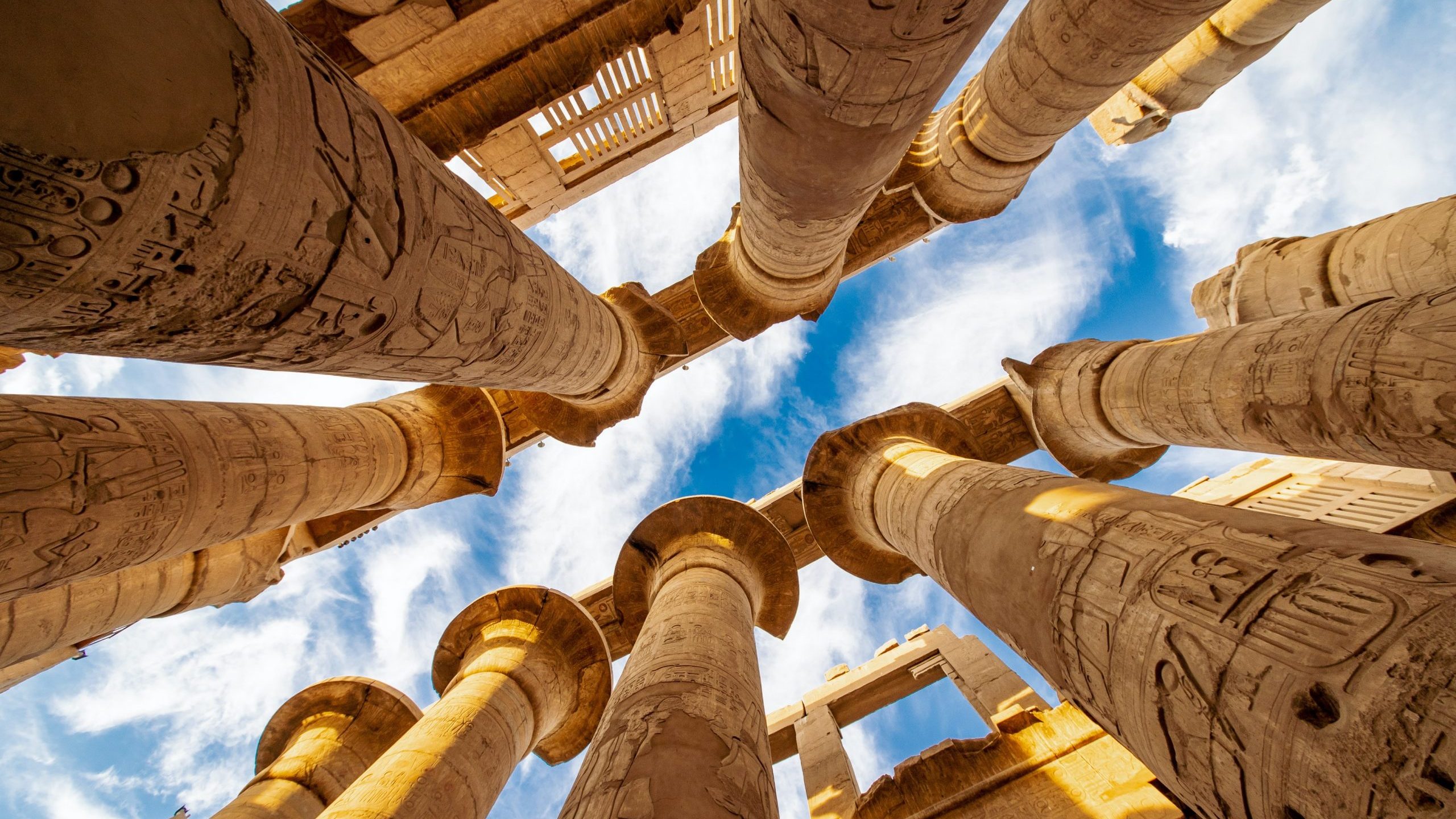7 Days tour
Day 1: Arrival
Today arrival to Cairo International Airport and meet your tour coordinator and driver. They will help you navigate your way through the airport and escort you to the hotel. Once at the hotel, the tour coordinator will provide details regarding Day 2 Excursions. You will spend the night in the hotel and awake for a day full of adventure.
Day 2 : Luxor
Be ready for an early flight to Luxor, the site of the famous Thebes and the World’s Largest Outdoor Museum. Whereas Egypt holds thirty percent of the world’s antiquities, Luxor holds seventy percent of Egypt’s antiquities. The importance of this city in Egypt’s history is unparalleled. Upon arrival to Luxor we will begin our day of touring in the west bank where we will start with the Valley of the Kings. After pyramid building began to wane, the kings still needed a final resting place to preserve themselves and store all their treasures. Housing nearly all the tombs for the kings of the 18th, 19th, and 20th dynasties, the Valley of the Kings was designed to help hide the burial places of the kings to prevent looting. One of the most famous tombs here is the tomb of Tutankhamen. We will have the opportunity to explore some of the tombs.
Next, we move to the temple of Hatshepsut . Hatshepsut was the wife of Thutmose II but became pharaoh after his death. This mortuary temple was modeled after Mentuhotep’s but at a much larger scale. We will explore this beautiful temple which is set into the cliffs at Deir el-Bihari. As we continue our sightseeing, we will move to Deir-el Medina, which is the ancient village of the craftsmen of the Valley of the Kings. Our last site to visit will be the Colossi of Memnon where you will see two (nearly 60 feet tall) seated statues of Amenhotep III. These statues were once the entrance to Amenhotep’s mortuary temple.
As our morning tour concludes, we head to lunch at a local restaurant. Once finished we travel to our hotel where we can check-in and relax before our afternoon tour of the East Bank continues.
The East Bank is filled with more sites to see. It is where we will find the Karnak and Luxor temples. The Karnak temple, also known as the Temple of Amun-Ra, honored not only Amun-Ra but Osiris, Montu, Isis, Ptah, and other Egyptian rulers. The area of Karnak Temple is around 200 acres, so it is immense. In fact, the debate is still on as to whether it or Angor Wat (in Cambodia) is the largest temple. As we leave Karnak, we will begin our trip to the Luxor temple. At one time there were sphinxes that lined a path from Karnak to Luxor, but it is not fully excavated. You will, however see a portion of the sphinx as it leads to the Luxor temple. Luxor temple is one of the most intact temples, so you will see many interesting statues, hieroglyphs, and rooms.
Our tour for the day concludes as we head back to our hotel for a relaxing evening. Meals included: breakfast, lunch
Day 3 : Aswan
Today we will enjoy breakfast before begging our expedition to Aswan. Along the way we will enjoy the scenery and farming life in Upper Egypt. Our drive continues until we reach Aswan. Aswan, located in southern Egypt, has served as the southernmost city in Egypt and is the third largest city in Egypt today. Once we arrive Aswan, we begin our touring at the Aswan High Dam. The High Dam was built between 1960 and 1970 to help control Nile flooding, provide water storage for irrigation, and to bring electricity to the people of Egypt. Prior to the High Dam being built, the Aswan Low Dam served to provide similar effects to the Nile River. Today the High Dam protects the Nile basin from flooding and droughts while providing jobs for many Egyptian people.
We then continue to Philae temple, one dedicated to Isis, the wife of Osiris and mother to Horus. It, too, was moved from its original location to one that was free from flooding. To get to the Philae temple you will take a water taxi. We will end our Aswan touring day with a felucca for a relaxing boat ride through Aswan. You will have the opportunity to not only enjoy the scenery but also to catch a glimpse of the Nubian village.
Overnight in Aswan. Meals included: breakfast, lunch
Day 4: Abu Simbel
After breakfast you head toward Abu Simbel. Abu Simbel is not only an amazing site built for Ramses II and his wife Nefertiti, but it also presents the amazing feat of ingenuity. In the 1960s the Egyptian government began construction on Aswan High Dam. Its purpose was to prevent the annual flooding of the Nile River and to bring electricity to all people of Egypt. The trouble with the High Dam was it would permanently flood many of the antiquities. As a result, massive projects were begun to help preserve these sites. Abu Simbel was one of them. Over the course of several years, Abu Simbel was cut apart and reconstructed on a higher plane, so visitors would still be able to stand in awe of ancient Egyptian ingenuity.
We then fly back to Cairo for overnight. Meals included: breakfast, lunch
Day 5 : Giza & Saqqara
After the breakfast at your hotel, you will be met by the Egyptologist who will provide your full day of touring. The adventure begins west of the Nile River in a town called Giza. It is here you will witness Egypt’s most visited attractions—the Pyramids at Giza and the Great Sphinx. Built for three kings of the Fourth Dynasty, the pyramids were designed to be the tombs of Khufu, Khafre, and Menkaure. In addition to the three main pyramids, you will see the queens pyramids and the Great Sphinx.
The next stop for today will be the ancient city of Saqqara, an amazing display of how tomb and pyramid-building progressed. Saqqara is a necropolis containing burials from different dynasties. It includes both royal and nonroyal tombs, mastabas, and cemeteries. We continue to the Serapeum of Saqqara where we will enter a series of tunnels to see the sarcophagi of the Apis bulls, sacred to the god Ptah.
Ptah was the local god of the town of Memphis, our next location. He was a patron of artisans and craftsman and was also considered a creator god. Memphis was founded in 2925 BC, and the Egyptian king Menes helped to unite Upper Egypt and Lower Egypt. In fact, Memphis was the capital at one point during the Old Kingdom. Memphis is an open air museum with many things to see such as a statue of Rameses II and the famous 80 ton sphinx made out of one gigantic piece of alabaster.
After you have explored the splendors of the day, you will return to your hotel, and you will be at leisure for the evening. Overnight in the hotel at Giza. Meals included: breakfast, lunch
Day 6: Cairo
Our first stop will be the Egyptian Museum. This museum houses over 120,000 artifacts from Egyptian history. Some of their most famous include the entire collection of Tutankhamen. Your guide will introduce some of the many important pieces as well as allow you some time to wander through the museum to peruse the collections. Once we finish with the museum, we will head to Abu Tarek for lunch. Abu Tarek is a multi-story restaurant that serves wonderful Koshary. It is definitely a special Egyptian treat.
You might have noticed a wall in parts of Cairo. This wall served to protect ancient Cairo and another city called Ayyubid from the Crusaders. Sala-Al-Din (Saladin) was the leader of the Ayyubid, and he decided to fortify both his city and ancient Cairo with this wall. It proved to be quite formidable as the Citadel of Saladin was nearly impenetrable. Today, as we learn about the history of the Citadel, we also venture inside the walls to the highest point, the Mohamed Ali Mosque. This ancient mosque is quite beautiful and will provide greater insight into most of the Egyptians’ religion, Islam.
Next up is the magical Khan el Khalili Bazaar. It is a wonderful depiction of an ancient outdoor shopping center. You will have the opportunity to wander the narrow alleyways and see many items unique to the Egyptian markets. As you continue to wander, you will have the opportunity to traverse Cairo’s oldest street—El-Moez Street. This pedestrian only street, just beyond Khan el Khalili, is an open-air museum and runs over half a mile. Moez Street is less touristy and provides those who travel it a unique look at Islamic architecture.
We then drive back to your hotel in Giza for the evening at leisure. Meals included: breakfast, lunch
**Ladies please consider bringing a scarf with you on our tour today. It will be needed to enter the Mohamed Ali Mosque. Also, conservative dress is required while inside the mosque
Day 7: farewell
Today will be the final day of our tour of the amazing Egypt, and you will be back to Cairo International Airport to catch your flight Thank you for spending the time with us. Meals included: breakfast


